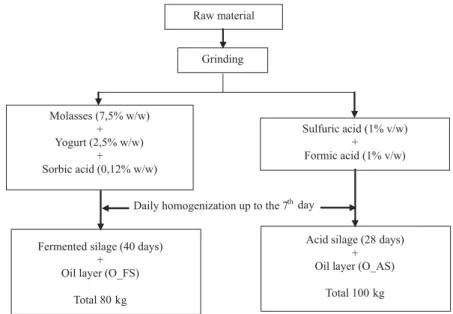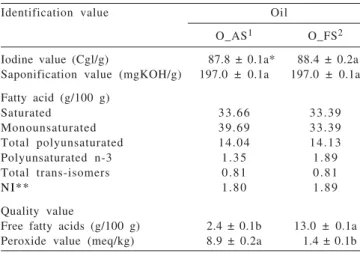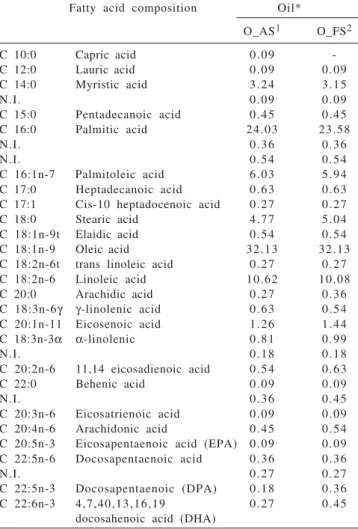Received September 24, 2009 and accepted August 27, 2010. Corresponding author: rosevi@pesca.sp.gov.br
Characterization of the oils present in acid and fermented silages produced
from Tilapia filleting residue
1Rose Meire Vidotti2, Maria Teresa Bertoldo Pacheco3, Giovani Sampaio Gonçalves2
1Financiado pela FAPESP processo no 01/02492-0. 2Instituto de Pesca de São Paulo.
3Instituto de Tecnologia de Alimentos.
ABSTRACT - The objective of this study was to determine the quality and composition of fatty acid in the lipid fraction of silages obtained from the residue of tilapia processing. Stratification of the lipid layer of the silages occurred at different times among the two types of silage (acid and fermented) and the greatest volume of oil was observed in acid silage (8.67% p/p). Although acid silage was more oxidized, it showed lower contents of free fatty acids probably because the degree of hydrolysis of its components is lower than that of fermented silage. Fatty acid composition did not differ among processes inasmuch as level of ϖ-3 was slightly higher in fermented silage. According to the degree of saturation,
monounsaturated fatty acids stood out as the predominant category in acid and fermented silages with values of 39.69% and 33.39%, respectively. The use of antioxidants in the silage is needed because the process of production is carried out at temperatures higher than room temperature. The oil in the silages has excellent nutritional value and contains fatty acids essential for animal feeding.
Key Words: fatty acids, fish oil, Oreochromis sp, silage
Caracterização dos óleos de silagens ácidas e fermentadas produzidas
com resíduos da filetagem de tilápias
RESUMO -O objetivo neste estudo foi determinar a qualidade e a composição em ácidos graxos da fração lipídica de silagens de resíduos do processamento de tilápias. A estratificação da camada lipídica das silagens foi realizada em tempos diferentes entre os dois tipos de silagem (ácida e fermentada) e o maior volume de óleo foi observado na silagem ácida (8,67% p/p). A silagem ácida apresentou-se mais oxidada, embora com menores teores de ácidos graxos livres, provavelmente porque o grau de hidrólise dos seus componentes é inferior ao da silagem fermentada. A composição em ácidos graxos não diferiu entre os processos, uma vez que o teor de ϖ-3 foi um pouco maior na silagem fermentada. De acordo com o grau de saturação, os ácidos
graxos monoinsaturados destacaram-se como a categoria predominante nas silagens ácida e fermentada, com valores de 39,69 e 33,39%, respectivamente. É necessário o uso de antioxidantes na ensilagem, uma vez que esse processo de produção é conduzido a temperaturas superiores à ambiente. O óleo das silagens tem excelente valor nutricional e contém os ácidos graxos essenciais à alimentação animal.
Palavras-chave: ácidos graxos, óleo de peixe, Oreochromis sp, silagem www.sbz.org.br
Introduction
Fish silage is an excellent source of protein. It is a product of high biological value for animal feeding that can be produced from dead fish, a byproduct from the fish industry, or from marine fishing, as well as from commercial fish waste which are considered raw materials with low quality and if not used may cause environmental, sanitary and economical problems (Vidotti et al., 2003).
Fish and fish oils have been extensively studied because of their countless benefits to animal health. Fish lipids are
a source of long chain polyunsaturated fatty acids known as ϖ-3, which are not synthesized by humans and the
majority of animal species. Recently, nutritionists have pointed up the advantages of a diet rich in monounsaturated (MUFA) and polyunsaturated (PUFA) fatty acids, such as the Mediterranean diet, for prevention of atherosclerosis. Thus, as a way of reducing the risk of cardiovascular disease, a diet with a PUFA, MUFA and SFA ratio of 1:1.5:1 has been recommended to be followed (Caldironi & Manes, 2006).
ϖ-3 fatty acids are essential for the development and
growth of those fish species (Haliloglu et al., 2004). Although the ratio between ϖ-3 and ϖ-6 is much lower
for freshwater fish compared to saltwater fish, approximately 1 to 4, both can be considered as a good source of these essential fatty acids (Steffens, 1997).
Lipid content is a good indicator of silage quality, because the fatty acids present in fish oil are highly unsaturated and therefore, easily to be oxidized. Oxidation can affect the nutritional quality of the product by making the proteins and amino acids unavailable and/or unpalatable (FAO, 2003).
The majority of the studies on the composition of fatty acid of fish oils refer to edible parts such as fillet and carcass. In Malaysia, a study conducted on the fatty acid composition of 20 freshwater fish species concluded that tilapia and red tilapia contain 35.1 and 37.7% of saturated fatty acids; 26.6 and 39.5% of monounsaturated fatty acids; and 18.4 and 21.6% of polyunsaturated fatty acids, respectively. Those values reflect the nutritional quality of the lipid fraction of these freshwater fish (Rahman et al., 1995). Body composition of cultivated tilapia varies, mainly, according to size, maturation stage, and culture management. Tilapias reared in cages in intensive systems present high content of visceral fat, consequently, the residue composition displays great content of lipids.
The objective of this study was to determine the lipid composition of both acid and fermented silage obtained from filleting residue of tilapia reared in ponds. Therefore, the supernatant lipid fraction of fermented and acid silage was identified and its quality was evaluated.
Material and Methods
Fresh residue from tilapia filleting process (Tilapia spp) was obtained daily from the slaughterhouse of Faculdade de Zootecnia e Engenharia de Alimentos – Universidade de São Paulo. The raw material included the residue, heads, carcasses and viscera.
The silage was produced using two 100-kg polyethylene containers. Fermented silage was produced from minced tilapia residue with the addition of: 2.5 % (w/w) expired yogurt; 7.5% (w/w) sugar cane molasses and 0.125% (w/w) sorbic acid as fungicide. The containers were initially filled up to 80% of their capacity because the volume of the ensiled mass increases due to gas production during the fermentation process. Acid silage was produced by adding to the minced residues 1% (v/w), formic acid and 1% (v/w) sulfuric acid (Figure 1).
The supernatant oil layer was collected after 28 and 40 days for the acid and fermented silages, respectively. Three samples were collected using a vacuum siphon, conditioned in amber flasks and left at room temperature (24 ± 3°C) until analysis. The analyses were carried out at Centro de Ciência e Qualidade de Alimentos (CCQA) do Instituto de Tecnologia de Alimentos (ITAL), Campinas, SP. The following analyses were performed according to methodology described in Firestone (1998): Iodine value (Method Id-87), saponification value (IF-96), and fatty acid composition (method Ce IF-96). Preparation of fatty acid methyl esters (FAMEs) from silages was performed according to Hartman & Lago (1973) and Horwitz method (AOAC, 2000). Quality values were evaluated following the
Figure 1 - Acid and fermented silage production.
Raw material
Grinding
Molasses (7,5% w/w) + Yogurt (2,5% w/w)
+
Sorbic acid (0,12% w/w)
Sulfuric acid (1% v/w) + Formic acid (1% v/w)
Fermented silage (40 days) +
Oil layer (O_FS)
Total 80 kg
Acid silage (28 days) + Oil layer (O_AS)
free fatty acids method (Method 5a-40, AOAC, 1998) and peroxide value (Method cd 8-53, AOAC, 1998).
The statistical analysis of the results for iodine, saponification, peroxid value and free fatty acids were done using ANOVA. Means that differed significantly were compared by Tuckey´s multiple range test PROC MIXED Statystical Analyses System - SAS (1996), at 5% probability range.
Results and Discussion
The silages were produced from residues generated daily during fish slaughtering and fillet processing, therefore, it was possible to control the process carefully.
After the 7th day of silage production process, the lipid layer in the supernatant began the stratification process. Oil separation increased at different volumes during the process. It was also observed that because the supernatant oil layer was formed at different times, the amount of oil produced varied from 8.65 to 6.77% in relation to the total ensiled mass, for acid and fermented silages, respectively (Table 1). The oil samples were collected after 28 and 40 days for the acid and fermented silage, respectively. The extraction of the oil layers was conducted only after the volume remained constant.
The polyethylene tanks containing the silage remained in the same room, where environmental temperature and humidity were the same. In such conditions, it was considered that the approximate difference of 2% in the lipid extract resulted from the hydrolisis present in the silage process. Therefore, the acid silage broke off more
effectively cell structures and lipid mycela contained in the biomass used as raw material, which resulted in more oil present. The process used to collect the lipid fraction did not use any drastic methodology such as centrifuge force to avoid any damages during the sample stratifications. It is possible that a more aggressive separation method would have resulted in larger differences.
A similar composition, relative to the non-saturation degree of fatty acids and content of saponifiable matter, was observed. The values reported are characteristic of freshwater fish. No discrepancies resulting from the methodology used were observed (Contreras-Guzman, 1994). The iodine index shows the unsaturation degree in the lipid fraction inasmuch as every double bond of a fatty acid can incorporate two halogen atoms. Therefore, the higher the degree of unsaturation of the fatty acids present in the lipid fraction the higher the capacity for iodine absorption and consenquently the iodine index. As it was expected, the values were similar (p<0.05) for both acid and fermented silage inasmuch as the poliunsaturated fatty acid values were not significantly different. According to Hardy & Keay (1972), there is an inverse relationship between the iodine index of lipids and the temperature of the environment. When temperatures are low, the need to keep the protoplasmatic lipids in the liquid form causes an increase in poliunsaturation.
The quality values that fermented silage suffered a more intense hydrolytic process (Table 1), which resulted in greater contents of free fatty acids (13 g/100 g) compared to the acid hydrolysis (2.4 g/100 g). In the acid silage, in addition to a more effective break up of the lipid mycela, the triacilglycerols were preserved at the pH value.
In the fermented silage, the triacilglycerols chain were more effectively broken up because of the microorganism action that were present in the medium, thus releasing greater amounts of fatty acids dispersed in the lipid fraction. However, the low peroxide content (1.4 meq/kg of oil) seemed to indicate that there was no oxidation in the material inasmuch as light incidence was controlled by the opacity of the containers.
The results seem to indicate that the processes that results in peroxidation and acidity in the silages occur by means of a differentiated mechanism, probably due to the biochemical processes involved in the hydrolysis of the raw material. Because the peroxide value measures oxidation in the initial stages of development, this may indicate that probably some component present in the commercial acids added to the raw material in the acid silage produced a more intense oxidation.
Identification value Oil
O_AS1 O_FS2
Iodine value (Cgl/g) 87.8 ± 0.1a* 88.4 ± 0.2a Saponification value (mgKOH/g) 197.0 ± 0.1a 197.0 ± 0.1a
Fatty acid (g/100 g)
Saturated 33.66 33.39
Monounsaturated 39.69 33.39
Total polyunsaturated 14.04 14.13
Polyunsaturated n-3 1.35 1.89
Total trans-isomers 0.81 0.81
NI** 1.80 1.89
Quality value
Free fatty acids (g/100 g) 2.4 ± 0.1b 13.0 ± 0.1a Peroxide value (meq/kg) 8.9 ± 0.2a 1.4 ± 0.1b
1Oil extracted from acid silage. 2Oil extracted from acid silage.
* Analyzed in triplicate. **Not identified.
a,b Means followed by the same letters are not significantly different (P<0.05) by
Tukey test.
Because composition of fat and oil is basically made up of the same fatty acids, the differences are in the amounts present in each one.
It can be verified that with respect to saturation degree of fatty acids, the following proportion was observed for saturated, monounsaturated, and polyunsaturated fatty acids: 0.86:1.0:0.35 and 1.0:1.0:0.42, for acid and fermented silage respectively (Table 2).
The lower proportion of polyunsaturated in acid silage may be related to high peroxide content, since fatty acids are very unstable and reactive. Monounsaturated fatty acids are more expressive compared to others, which gives these oils an especial healthy connotation.
Among the saturated fatty acids, palmitic and estearic presented the highest values, similar to the values found by Maia et al. (1998) and Geron et al. (2007). Palmitic acid is the most widely distributed in nature, and it is present throughout the food chain. It can be found in the oil composition of every aquatic plant and animal, acting as the
precursor of long chain saturated and unsaturated fatty acids (Moretto & Fett, 1998).
High content of oleic acid was observed in the monosaturated fats. This acid can be found abundantly in olive oil (up to 75%); but in oils of animal origin it never exceeds 40%. Oils rich in monounsaturated fatty acids when ingested by humans and healthy animals, reduce both LDL plasmatic and oxidized concentrations, probably by increasing the activity of the LDL receptors (Bittencourt Júnior & Senna, 2002). In the present study, the oil composition displayed 32% of oleic acid, which makes it an excellent source of this acid in the food chain as precursor in the formation of n-3 fatty acids and increase of the activity of LDL receptors.
With respect to fatty acid groups that make up the lipids in the silages, the n-9, ϖ-6 and n-3 groups were observed
in the following ratios: 1:0.42:0.04 and 1:0.41:0.06 for the acid and fermented silage, respectively. The slightly higher content of ϖ-3 in the fermented silage may be related to the
lower oxidation degree inasmuch as these polyunsaturated are very unstable.
Conclusions
Acid silage separates the lipid fraction more whereas fermented silage presents greater content of free fatty acids. The individual fatty acid contents are similar in both processes. The oils obtained during the ensiling processes show excellent nutritional value and can be used in animal feeding as a source of essential fatty acids. However, the analysis results show the need to use antioxidants during the production process.
References
BITTENCOURT JÚNIOR, P.I.H.; SENNA, S.M. Ácidos graxos e aterosclerose. In: CURI, R.; POMPÉIA, C.; MIYASAKA, C.K. et al. (Eds.) Entendendo a gordura: os ácidos graxos. 1.ed. São Paulo: Manole, 2002. p.539-554.
CALDIRONI, H.A.; MANES, M.E. Proximate composition, fatty acids and cholesterol content of mest cuts from tegu lizard Tupinambis merianae. Journal of Food Composition and Analysis, v.19, p.711-714, 2006.
CONTRERAS-GUZMAN, E.S. Bioquímica de pescados e derivados. Jaboticabal: FUNEP, 1994. 409p.
FOOD AND AGRICULTURAL ORGANIZATION - FAO [2003]. Animal feed resources information system. Available in: <www.fao.org>. Accessed in: 20/3/2008.
FIRESTONE, D. Oficial methods and recommended pratices of the American Oil Chemistis Society - AOCS. 5.ed. v. I – II, Champaing, 1998.
GERON, L.J.V., ZEOULA, L.M., VIDOTTI, R.M. et al. Chemical characterization, dry matter and crude protein ruminal degrability and in vitro intestinal digestion of acid and fermented
1Oil extracted from acid silage; 2Oil extracted from acid silage; *Analyzed in
duplicate.
Fatty acid composition Oil*
O_AS1 O_FS2
C 10:0 Capric acid 0.09
-C 12:0 Lauric acid 0.09 0.09
C 14:0 Myristic acid 3.24 3.15
N.I. 0.09 0.09
C 15:0 Pentadecanoic acid 0.45 0.45
C 16:0 Palmitic acid 24.03 23.58
N.I. 0.36 0.36
N.I. 0.54 0.54
C 16:1n-7 Palmitoleic acid 6.03 5.94
C 17:0 Heptadecanoic acid 0.63 0.63
C 17:1 Cis-10 heptadocenoic acid 0.27 0.27
C 18:0 Stearic acid 4.77 5.04
C 18:1n-9t Elaidic acid 0.54 0.54
C 18:1n-9 Oleic acid 32.13 32.13
C 18:2n-6t trans linoleic acid 0.27 0.27
C 18:2n-6 Linoleic acid 10.62 10.08
C 20:0 Arachidic acid 0.27 0.36
C 18:3n-6γ γ-linolenic acid 0.63 0.54
C 20:1n-11 Eicosenoic acid 1.26 1.44
C 18:3n-3α α-linolenic 0.81 0.99
N.I. 0.18 0.18
C 20:2n-6 11,14 eicosadienoic acid 0.54 0.63
C 22:0 Behenic acid 0.09 0.09
N.I. 0.36 0.45
C 20:3n-6 Eicosatrienoic acid 0.09 0.09
C 20:4n-6 Arachidonic acid 0.45 0.54
C 20:5n-3 Eicosapentaenoic acid (EPA) 0.09 0.09 C 22:5n-6 Docosapentaenoic acid 0.36 0.36
N.I. 0.27 0.27
C 22:5n-3 Docosapentaenoic (DPA) 0.18 0.36
C 22:6n-3 4,7,40,13,16,19 0.27 0.45
docosahenoic acid (DHA)
silage from tilapia filleting residue. Animal Feed Science Tecnology, v.137, p.226-239, 2007.
HALILOGLU, H.I.; BAYIR, A.; SIRKECIOGLU, A.N. et al. Comparison of fatty acid composition in some tissues of rainbow trout (Oncorhynchus mykiss) living in seawater and freswater.
Food Chemistry, v.86, p.55-59, 2004.
HARDY, R.; KEAY, J.N. Seasonal variations in the chemical composition of Cornish mackerel, Scomber scombrus (L.), with detailed reference to lipids. Journal of Food Technology, v.1, p.125-137, 1972.
HORWITZ, W. Oficial methods of analysis of AOAC International. 17.ed. Gaithersburg, Maryland, 2000. p.25-26. HARTMAN, L.; LAGO, R.C.A. Rapid preparation of fatty acid methyl esters from lipids. Laboratory Pratice, v.22, p.475-476, 1973.
MAIA, W.M.; NUNES, M.L.; FIGUEIREDO, M.J. et al. Caracterização da fração lipídica da silagem de resíduo de tilápia
para utilização em rações para aqüicultura. In: SIMPOSIO BRASILEIRO DE AQÜICULTURA, 10., 1998, Recife. Anais...
Recife: Persona, 1998. v.2, p.55-64.
MORETTO, E.; FETT, R. Te c n o l o g i a d e ó l e o s e g o r d u r a vegetais na indústria de alimentos. São Paulo: 1998. 149p. RAHMAN, S.A.; HUAH, T.S.; HASSAN O. et al. Fatty acid composition of some Malaysian freshwater fish. F o o d Chemistry, v.54, p.45-49, 1995.
STATISTICAL ANALYSIS SYSTEM - SAS. SAS user’s guide: statistics; version 9.1. Cary: SAS Institute. 1996. 365p. STEFFENS, W. Effects of variation in essential fatty acids in fish
feeds on nutritive value of freshwater fish for humans.
Aquaculture, v.151, p.97-119, 1997.
VIDOTTI, R.V.; VIEGAS, E.M.M.; CARNEIRO, D.J. Amino acid composition of processed fish silage using different raw materials.


